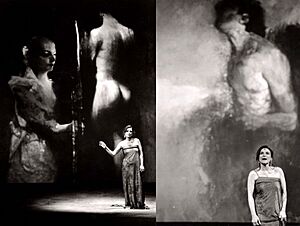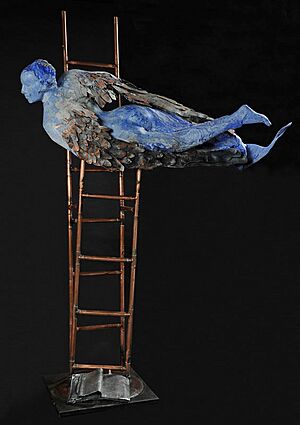Alessandro Kokocinski facts for kids
Alessandro Kokocinski (born Alejandro Kokocinski) was a talented artist. He was a painter, sculptor, and set designer. Born in Italy in 1948, he later became Italian-Argentine. His family had roots in Poland and Russia. He passed away in 2017.
Contents
Early Life and Adventures
Alessandro was born in a refugee camp in Porto Recanati, Italy. His mother had escaped difficult times, and his father had fought in the war. In 1948, his family moved to South America.
He spent his early years exploring forests in Misiones and Iguazú. He also lived in Paraguay and the Chaco region. Later, in Buenos Aires, Argentina, he saw important historical events, like the fall of President Juan Perón in 1955.
A Career in Art and Theatre
When Alessandro was young, he joined a circus in Argentina. This experience likely inspired some of his later artwork. He soon moved into theatre, studying how to design sets for plays. A set designer creates the scenery and props for a show.
He had to leave Argentina and find safety in Santiago, Chile. There, he showed his drawings about social issues at different universities. Famous art critics and writers supported his work.
Kokocinski helped with a project at the Catholic University of Santiago de Chile. He was already in Europe when the government changed in Chile. He first showed his art in Hamburg, Germany, and then in Rome, Italy. The famous poet Rafael Alberti even wrote a poem about him!
Alessandro settled in Rome and learned from another artist, Riccardo Tomassi Ferroni. They shared a studio. In 1986, he traveled to the Far East, living in places like Southeast Asia and China for a few years. He then moved to Germany for four years in the late 1980s.
He eventually returned to Italy for good. There, he started a theatre company called Kosa with actress and singer Lina Sastri. He designed the lights, costumes, and sets for six of their shows.
In 2003, he moved to Tuscania, Italy. He set up his art studio in an old, unused church. He also started the Fondazione Alessandro Kokocinski. This foundation helps young artists from all over the world. It offers training, special courses, and places for artists to live and work. It also hosts exhibitions and events.
In 2016, Kokocinski designed the set and lighting for a musical show called Lina Sastri è il mio nome. It opened in Rome. Lina Sastri praised his "amazing imagination" and how he saw the world "through the eyes of the heart." She hoped the audience would enjoy his "visually dramatic touch."
Important Art Exhibitions
Alessandro Kokocinski had many important art shows around the world.
- In 1969, he had his second solo show in Buenos Aires. It featured black and white pencil drawings. These drawings showed the difficulties of poverty, work, and suffering.
- In 1979, he took part in a group show in Amsterdam called "The image of man from 1945 to the present." It explored how art showed humanity after World War II.
- In 1987, eighteen of his artworks were shown at the Hong Kong Arts Festival. These pieces often featured circus themes, like acrobats, dancers, and leaping horses.
- In 1999, three exhibitions in Rome celebrated Kokocinski as a "world traveler." His portraits of people showed strong feelings and pain. He used layers of paint and faded colors to make them more dramatic.
- In 2003, Palazzo Venezia in Rome held a big exhibition of his work. It included over sixty pieces from his long career. One important work was La Trasfigurazione. This was a very large artwork, over 4 meters tall and 14 meters long. It was made of five colorful sculptures on wooden panels.
- In 2005, he had an exhibition at the Museo Nazionale di Castel Sant' Angelo in Rome. It featured sculptures inspired by the philosopher Giordano Bruno.
- In the same year, he joined a group show in Turin, Italy, called "Evil – Exercises in Cruel Painting."
- One of his biggest achievements was a solo show in 2006 in Beijing, China. It was held at the National Art Museum of China (NAMOC) as part of a celebration of Italian culture in China.
- In 2008, he presented a series of paintings called "The Power of the Spirit" in Rome. These paintings were inspired by classical art and myths.
- In 2009, he was a popular artist in a group exhibition in Milan called "Las Americas latinas."
- In 2011, Kokocinski was chosen to show his art at the 54th Venice Art Biennale. This is a very famous international art event.
- In 2013, a gallery in Milan showed his drawings. These drawings were made on old books and paper, and their theme was the circus.
- In 2015, a large exhibition in Rome called "Kokocinski. The life and the Mask: from Pulcinella to Clown" explored his art. It showed how his own experiences, like being an exile, influenced his work. The exhibition highlighted how masks, clowns, and the Italian character Pulcinella became important in his art. These works showed "the spectacle of human fragility" and figures "full of hope, always struggling to defend the true sense of existence."
Death
Alessandro Kokocinski passed away on December 12, 2017, in Tuscania, Italy. He was 69 years old and had been ill for some time.
Images for kids




